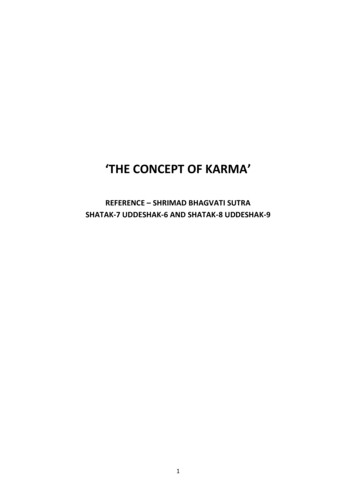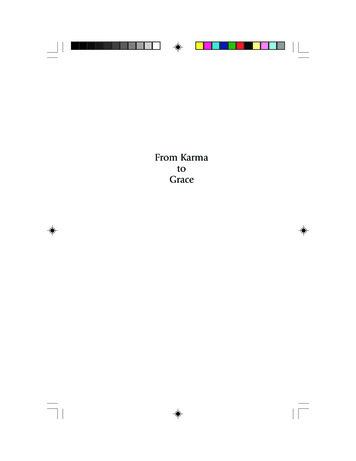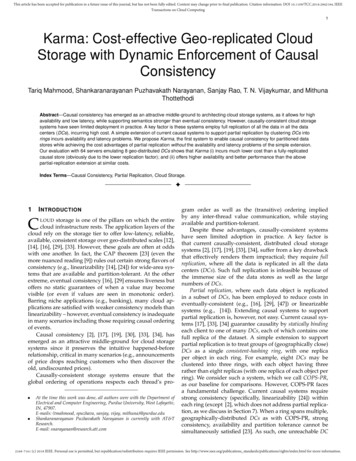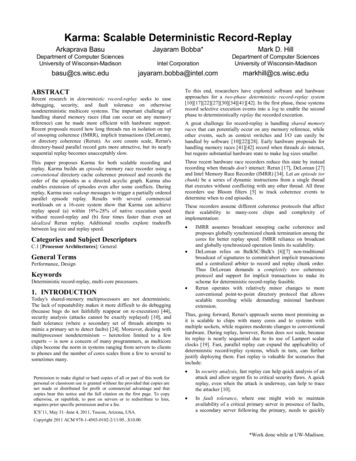
Transcription
MNRAS 501, 356–366 (2021)doi:10.1093/mnras/staa3676Advance Access publication 2020 November 26Analysis of the Karma asteroid familyDebora Pavela ,1‹ Bojan Novaković ,1‹ Valerio Carruba2and Viktor Radović11 Department2 Saoof Astronomy, Faculty of Mathematics, University of Belgrade, Studentski trg 16, 11000 Belgrade, SerbiaPaulo State University (UNESP), School of Natural Sciences and Engineering, Guaratingueta, SP, 12516-410, BrazilAccepted 2020 November 19. Received 2020 November 17; in original form 2020 July 25The Karma asteroid family is a group of primitive asteroids in the middle part of the main belt, just at the outer edge of the 3J:1Amean-motion resonance. We obtained the list of the family members with 317 asteroids, and estimated that it was formed by thecatastrophic disruption of a parent body that was between 34 and 41 km in diameter. Based on the V-shape method, age of theKarma family is estimated to be about 137 Myr. A detailed dynamical map of the region combined with numerical simulationsallowed us to reconstruct the long-term dynamical evolution of the family, and to identify the mechanisms responsible for thisevolution. The numerical simulations successfully reproduced the main features in the orbital distribution of the family membersbut also showed that some regions of the Karma family could be missing. A more detailed analysis revealed that these regionslikely consist of very dark objects, fainter than absolute magnitude H 17, that have not yet been detected. Based on theobtained results, we concluded that magnitude–frequency distribution of family members up to H 16 mag is neither affectedby dynamical erosion nor observational incompleteness, and therefore represents the result of collisional grinding of the originalfamily population. Finally, we found that the Karma family have been supplying some asteroids to the near-Earth region via the3J:1A resonance. Currently, there should about 10 family members larger than 1 km in diameter, orbiting in the near-Earth space.Key words: celestial mechanics – minor planets, asteroids: general – methods: numeric.1 I N T RO D U C T I O NAn asteroid family is a group of asteroids with similar orbitalelements, mostly formed by asteroid collisions. When the collisionhappens, fragments from the parent body are ejected in the nearbyspace, forming a cloud-like formation around the location wherethe collision took place. Such groups may be identified as asteroidfamilies, in some cases even a billion years after the original collision.Studies of asteroid families are important from many points ofview. For instance, identification of the families and their formationrate give an overview of how the collisional evolution affected themain asteroid belt (Bottke et al. 2015). Families allow studyingimpact physics involving the disruption of large bodies, and theirejected fragments, which can not be done in laboratories in the samesize range. Also, spectroscopic observation of family members cangive us insights into the internal mineralogical structure of the parentbody (Mothé-Diniz & Carvano 2005a; Masiero et al. 2015).Families of primitive taxonomic composition are those formed bybreak-ups of dark carbonaceous parent asteroids. Primitive familieslocated in the inner part of the main belt have received lots of attentionin the recent years (see Morate et al. 2019, and references therein),mostly because they were identified as potential sources of twonear-Earth asteroids (NEAs) (101955) Bennu and (162173) Ryugu,targets of the sample-return missions OSIRIS-REx and Hayabusa2,respectively (Bottke et al. 2015b). Also, over the last decade,increased attention has been paid to the primitive families locatedin the outer part of the main belt (De Prá et al. 2020), mainly due E-mail: debbiepavela2@gmail.com (DP); bojan@matf.bg.ac.rs (BN)to their possible connection with main-belt comets (MBCs) (see e.g.Hsieh et al. 2018), and more recently with Jupiter family comets(Hsieh et al. 2020).Here, we study the (3811) Karma asteroid family, a group ofprimitive asteroids situated in the middle part of the main asteroidbelt. This is an interesting family, that is important to study formany reasons. Families interacting with week and moderately strongsecular resonances, such as the Karma, may in some cases help usto reconstruct parameters of the collision event that produced thefamily (Carruba, Vokrouhlický & Novaković 2018), and to improveour knowledge of the impact physics. Also, being located close tothe edge of the powerful 3J:1A MMR with Jupiter, the Karma familylikely supplied some asteroids to the near-Earth region. Moreover,observational studies of the Karma family asteroids may provideimportant clues about the innermost icy-asteroids in the main belt.Still, the Karma family has not attracted much attention amongresearchers in the past, probably due to a limited amount of dataavailable about the asteroids belonging to it. This situation haschanged in the meantime, and the data available now allow tostudy the family from different perspectives, and to draw reliableconclusions. In this work, we present a comprehensive study of theKarma family, focusing on its dynamical evolution.2 K A R M A FA M I LY: BA S I C P RO P E RT I E S2.1 Membership and spectral reflectance characteristicsAny analysis of an asteroid family depends on the accuracy ofidentification of its members. Detection of asteroid families and C 2020 The Author(s)Published by Oxford University Press on behalf of Royal Astronomical SocietyDownloaded from 006885 by 10390485 user on 21 December 2020ABSTRACT
Karma asteroid family3570.20.250.15Geometric albedo, pv0.425Number of asteroids20151050Figure 1. Number of asteroids associated with the Karma family (shownas orange stars), and a value of the slope γ of the cumulative magnitudedistribution fitted in the range H [15, 17] (presented as dark blue circles),as a function of the HCM’s cut-off velocity v c . Adopted nominal cut-off isv c 55 ms 1 .identification of their members is typically performed using properorbital elements: semimajor axis ap , eccentricity ep , and inclination ip(Zappala et al. 1990; Milani et al. 2014; Nesvorný, Brož & Carruba2015), though, in principle, this could be done also in the spaceof proper frequencies (Carruba & Michtchenko 2007). Here, weused the catalogue of the proper elements of numbered and multiopposition asteroids, with 631 226 objects in total, available at theAsteroid Families Portal.1The most widely used algorithm to identify members of an asteroidfamily is the Hierarchical clustering method (Zappala et al. 1990). Inthis method, distances in terms of velocity among all combinationsof asteroids are computed, and objects mutually closer than a giventhreshold distance v c (often called the cut-off velocity) are assumedto be family members. Adopting an appropriate v c is, however, notalways straightforward. Usually, a plot showing how the number offamily members N depends on v c is created, and the nominal v c isadopted as a centre of the interval where N grows only moderately(e.g. Novaković, Cellino & Knežević 2011). However, in the caseof the Karma family, such a plateau does not exist. As can be seenin Fig. 1, a core of the family is identified at 35 ms 1 , and thenumber of associated members grows steadily until 80 ms 1 , whenthe family merges with a local background population of asteroids.Therefore, in this case any value between 40 and 75 ms 1 is a possiblenominal cut-off distance v c . Here, we adopt a value of v c 55 ms 1as the nominal cut-off, which connects 332 asteroids to the Karmafamily.2 This is a relatively conservative value that allows reducingthe number of interlopers associated with the family, with a cost ofpotentially missing some family members.However, even when an asteroid family is determined in the properelement space, not all associated asteroids are real family members.Despite using a somewhat lower value of the cut-off velocity v c 55 ms 1 , the list of the family members obtained by the HCMunavoidably includes some interlopers. As members of an asteroidfamily are typically homogeneous in composition (Mothé-Diniz,Roig & Carvano 2005b; Parker et al. 2008; Carruba et al. 2013),1 php2 Notethat at this cut-off the lowest numbered asteroid associated with thefamily is (500) Selinur. This object is however definitely an interloper as itsspectral type (Lazzaro et al. 2006) and albedo (Masiero et al. 2011) are bothincompatible with C-type taxonomic classification of the Karma family.0.050.10.30.35Figure 2. The number frequency distribution of albedos of the Karma familymembers. The family belongs to C taxonomic type, with members’ geometricvisual albedos smaller than 0.1. The objects with larger albedos are most likelyto be interlopers.to find interlopers of the family we have to consider information onthe composition of each member (e.g. Masiero et al. 2015; Radovićet al. 2017). Surface reflectance characteristics of family membershave been used to improve the membership, by identifying andremoving potential interlopers.The most common information in thisrespect is asteroid albedo. An average albedo of family members cantell us to which spectral complex family belongs. Comparing theaverage family albedo and measured albedos of individual familymembers, potential interlopers can be identified.3 In particular, tothis purpose, we have used WISE albedos (Masiero et al. 2011)and found measured albedos for 146 family members. Because theKarma family consists of dark asteroids, as can be seen in Fig. 2, weremoved from the family 15 asteroids with an albedo above 0.1. Afterremoving these objects, we found the mean geometric albedo of thefamily of pv 0.055 0.014. Also, we have investigated availablecolours of family members in the fourth Release of the Sloan DigitalSky Survey (SDSS) Moving Object Catalogue (Ivezic et al. 2002).We found that this catalogue contains colours of 55 family members.Based on this data, and following Radović et al. (2017), we wereable to reliably identify only one potential interloper, the asteroid(38685) 2000 QP9 . However, as this object was already marked asthe interloper based on its albedo, no additional asteroid has beenremoved from the family based on the SDSS colours.In Fig. 3, we show all asteroids associated to the family inthe semimajor axis versus absolute magnitude plane. Due to theYarkovsky effect, an asteroid family in this plane4 typically form aV-shape like structure, and real family members are expected to belocated inside the boundaries of the V-shape. We note that most ofthe identified interlopers are located outside the V-shape boundaries,3 Dueto the limitations of asteroid surveys, albedo is not measured for allasteroids. This can result in having more interlopers in the family than initiallyidentified. Apart from this, the efficiency of the identification of interlopersdepends on how different in composition family members are concerningnearby non-family members. As in many cases, families are taxonomicallyindistinguishable from non-family asteroids (Erasmus et al. 2019), only incases when family and background asteroids are of different composition,interlopers could be efficiently identified.4 Except in the semimajor axis versus absolute magnitude plane, the V-shapestructures are also visible in the semimajor axis versus inverse diameter plane.In the latter case, the boundaries of the V-shaped region are straight lines,because the Yarkovsky induced drift rate scales inversely with diameter.MNRAS 501, 356–366 (2021)Downloaded from 006885 by 10390485 user on 21 December 20200
358D. Pavela et al.40(3811) Karma family3518Number of asteroidsAbsolute magnitude, H per orbital semi-major axis, ap [au]2.64Figure 3. Karma family members determined by the HCM with v c 55 ms 1 , projected on to a plane of proper semimajor axis versus absolutemagnitude. The family members are shown as orange circles, while theidentified interlopers are marked as blue squares.02.522.582.62.622.542.56Proper orbital semi-major axis, ap [au]2.64Figure 5. Histogram of the proper semimajor axis of the Karma familymembers.around ap 2.62 au. Likewise, analogous features are visible in theap sin (ip ) plane. All these point out towards significant dynamicalevolution of the family.The number–frequency distribution of family members in termsof the semimajor axis, shown in Fig. 5, reveals a concentrationof asteroids near the family edges. The fact that small membersaccumulate at the extreme semimajor axis values has been alreadynoted in some families (see e.g. Vokrouhlický et al. 2015, andreferences therein). This formation of ‘ears’ is a consequence of theYarkovsky–O’Keefe–Radzievskii–Paddack (YORP) effect, whichdrives asteroids’ obliquity toward 0o or 180o (spin axis perpendicularto the orbital plane), and therefore maximizes the Yarkovsky drift(Vokrouhlický et al. 2006b).The distribution in Fig. 5 is also slightly asymmetric with respectto the centre of the family, with the left-hand side of the family interm of the proper semimajor axis being overpopulated by about15 per cent. A similar pattern has been also found in other familiesand the most recent in the Clarissa family (Lowry et al. 2020). Thismight be a consequence of dynamical erosion of the family, but itmight also be related to an impact geometry during the collisionalevent that produced more retrograde than prograde rotators (see e.g.discussion in Milani et al. 2014; Lowry et al. 2020).2.2 Magnitude distribution and parent body sizeFigure 4. Karma family members determined by the HCM with v c 55 ms 1 . Projection is on to a plane of the proper semimajor axis and sineof proper inclination (top panel) and a plane of the proper semimajor axisand proper eccentricity (bottom panel). The family members are shown asorange circles, while the identified interlopers are marked as blue squares. Inaddition, locations of major resonances are labelled and shown on the plot.Note that the locations of the secular resonances are labelled only in the upperpanel.providing additional evidence that these objects are not real familymembers.A simple analysis of the distribution of family members inthe ap ep and ap sin (ip ) planes, shown in Fig. 4, reveals someinteresting features. Family members are more dispersed at family’sedges, in terms of the proper semimajor axis. For instance, in theap –ep plane (top panel in Fig. 4) spreading around 2.54 au is abouttwice as large as the one at about 2.58 au. Although less noticeable,a similar pattern is also visible near the outer edge of the family,MNRAS 501, 356–366 (2021)Important information to gain from each asteroid family is itsmagnitude (size) distribution (Masiero et al. 2015). Fig. 1 showshow a slope γ of the cumulative magnitude–frequency distributionfor H [15, 17], changes for different values of the cut-off velocityused to define the family. For our nominal family, defined at v c 55 ms 1 , the slope is γ 0.50. This relatively shallow slope isnot expected for 200 Myr old families like the Karma family (seeSection 2.4), and it may suggest that some small members of thefamily are missing.To examine this possibility, we identify the absolute magnitudecompleteness limit of the family, using an approach similar to the oneproposed by Novaković (2010). We found that this limit, in the rangeof the semimajor axis covered by the family, is at H 16.1 mag. Sincethe orbital inclination of the family is around 11 degrees, and mostsky surveys for asteroids are in favour of detecting asteroids movingclose to the ecliptic plane, the completeness limit of the Karma familyshould be slightly lower, around an absolute magnitude of H 16.Therefore, we expect some of the family members to be missing inthe magnitude range 15–17. A possible additional loss of the familyDownloaded from 006885 by 10390485 user on 21 December 202010
Karma asteroid family2.3 Dynamical environmentTo study the physics of the collisional events from which familiesoriginate, the initial state of these families need to be reconstructed.In this respect, both the collisional and dynamical evolution have tobe considered. Dynamical evolution is caused by different gravitational and non-gravitational perturbations resulting in modificationof an initial orbital structure of a family over time. The relevantgravitational effects are close encounters and resonances, while themain non-gravitational force is the Yarkovsky effect. The resonancesmainly change orbital inclination and eccentricity, meanwhile, theYarkovsky effect results in the dispersion of family members interms of orbital semimajor axis (Bottke et al. 2006b). On the otherhand, effects of close encounters may affect all three proper orbitalelements, but they depend on the mass of a perturbing body andgenerally are a less important type of the perturbations in the mainbelt. These mechanisms may cause significant orbital evolutionof asteroid families, which, in turn, may result in unusual shapes(Bottke et al. 2001; Novaković et al. 2015), and/or removal ofa significant fraction of family members, that is in some casesconnected with a supply of meteorites to the Earth (Zappalà et al.1998; Vokrouhlický, Bottke & Nesvorný 2017; Schmitz et al. 2019).The above-described evolution could be successfully modelled, onlyif the ages of the asteroid families are known. Today’s availablemethods for age determination can provide ages for practically allfamilies (see e.g. Nesvorný et al. 2015; Spoto, Milani & Knežević2015; Milani et al. 2017). However, some of these estimations havelarge uncertainties, which can affect the model of family evolution.Therefore, of particular interest are families whose ages could bereasonably well constrained.Level of the dynamical evolution of an asteroid family depends onits age, but also on the dynamical characteristics of the region wherethe family is located. We identify various mean-motion resonances(MMRs) and some secular resonances that cross the region. Themost important resonances are shown in Fig. 4. These include threebody MMRs (Nesvorný & Morbidelli 1998), between either Jupiter,Saturn, and asteroid (2J 2S -1A, 9J -1S -3A, 7J -3S -2A, 5J 2S-2A) or Jupiter, Mars, and asteroid (1J -2M 4A), and twobody resonance with Saturn (7A:1S). The most important secularresonances5 are the g g6 s s6 and s s6 g5 g6 thatintersects the family near the inner and outer edge, respectively (see5 Theg, s, g6 , s6 , gv , sv denote proper frequencies of longitude of theascending node and longitude of perihelion, of an asteroid, Saturn and Vesta,respectively.Lyapunov time, Tlyap [kyr]1000001000010001001012.52.522.54 2.56 2.58 2.6 2.62Proper semi-major axis, ap [au]2.642.66Figure 6. Lyapunov times in the region inhabited by the Karma family. Thesmaller values indicate less stable orbits.Fig. 4). Furthermore, the secular resonance g gv s sv withasteroid (4) Vesta (Tsirvoulis & Novaković 2016) is also crossing thefamily, but its importance seems to be minor.The dispersion of the Karma family members close to the inneredge of the family is mostly caused by the 3J:1A resonance withJupiter, and the g g6 s s6 secular resonance, while the mainactor in scattering the family members close to the outer edge isprobably the s s6 g5 g6 secular resonance.In Fig. 6, we show Lyapunov times6 as a function of the propersemimajor axis. These results suggest that most of the asteroids inthis region reside on relatively stable orbits (Tlyap 100 kyr), butthere is also a significant fraction of highly unstable orbits (Tlyap 20 kyr). The most chaotic orbits are associated with the 3J:1Aresonance with Jupiter (Tlyap 10 kyr)2.4 AgeTo reconstruct the dynamical evolution of the Karma family, the ageof the family has to be known, however, we did not find any ageestimation available in the literature. Therefore, for the family ageestimation, we utilized the so-called V-shape method as proposed bySpoto et al. (2015).We first analyse the V-plot of the family looking for possibleasteroids which are significantly displaced concerning the bordersof the V-shape plot. However, apart from the interlopers alreadyremoved in Section 2.1, we did not find any additional outlier. Thenext step was to select the fitting range in terms of 1/D and to divideit in an appropriate number of bins. We found that boundaries of theKarma family V-shape are well defined for 1/D 0.5 ms 1 , i.e. forobjects larger than 2 km in diameter (Fig. 7). Accordingly, we dividethis range of the 1/D axis into eight bins, in such a way that each bincontains roughly the same number of members. For the left-hand ofthe family, we select the minimum value of ap and the corresponding1/D in each bin, while for the right-hand side, we select the maximumvalue of the proper semimajor axis and its corresponding value of1/D. Then, we use the least-squares method to fit the data on bothsides of the V-shape, with straight lines (see Fig. 7). This way, weobtain the slopes of the V-shape.6 TheLyapunov time indicates the characteristic time-scale on which adynamical system becomes chaotic. Time limits on the predictability of orbitalmotion of an asteroid are typically several Lyapunov times.MNRAS 501, 356–366 (2021)Downloaded from 006885 by 10390485 user on 21 December 2020members due to their dynamical evolution will be further analysedin Section 3.The size of the parent body can be estimated in at least threedifferent ways: (i) as a sum of diameters of two largest fragments(Tanga et al. 1999), (ii) from SPH simulations (Durda et al. 2007),and (iii) simply by summing up volumes of all family members andby determining a diameter of resulting spherical body (Novaković2010). For simplicity, here we use the approaches (i) and (iii) andfound that the Karma family parent body was between 34 and 41 kmin diameter. Though the first method that we used here generallyunderestimates the size of the parent body due to the membersnot associated to the family, the second one should not be affectedas long as the two largest family members are reliably identified.Nevertheless, we note that, in principle, the parent body might be afew kilometres in the diameter larger.359
360D. Pavela et al.3.2 Synthetic Karma family: initial conditionsFigure 7. The V-shape of the Karma family. Family members are representedin orange, while black stars show family members of every bin that are usedfor fitting.To compute the age of the family, we also need to consider theYarkovsky effect. The estimated maximum value of the Yarkovskyinduced secular drift (da/dt)max for a hypothetical family member ofD 1 km in diameter is obtained using an available model of theYarkovsky effect (Vokrouhlický et al. 2015). The adopted thermalparameters are ρ s ρ b 1190 kg m 3 for the surface and bulkdensities respectively, and thermal inertia of 350 J m 2 s 1/2 K 1 ,based on the recent findings of the OSIRIS-REx and Hayabusa2missions (Lauretta et al. 2019; Watanabe et al. 2019). The resultingmaximum drift speed of 1 km asteroid is estimated to be about8 10 4 au Myr 1 .Combining the maximum Yarkovsky drift speed and the slopes ofthe V-shape plot, we estimate that the Karma family is 137 21 Myrold. We will consider this value as a nominal age of the Karmafamily.It should be noted, however, that any method for age determinationhas some limitations. The Yarkovsky-based V-shape methods dependon the Yarkovsky calibration, and, to some degree, on the initial stateof the family. In the case of the Karma family, using the Yarkovskycalibration adopted by Spoto et al. (2015), of (da/dt)max about6 10 4 au Myr 1 , would result in an older age of 181 27 Myr. Onthe other hand, the results obtained using the version of the method asproposed by Spoto et al. (2015) do not directly depend on the initialsize of a family, but the ages could still be somewhat overestimatedin case the ejection velocity field produces an initial V-shape ofthe family, not related to the Yarkovsky effect. For these reasons,the real uncertainty of our age estimation might be a somewhatlarger.3 N U M E R I C A L S I M U L AT I O N S3.1 MethodThe dynamical evolution is simulated by performing a set ofnumerical integrations, using the multipurpose OrbFit softwarepackage (available from http://adams.dm.unipi.it/orbfit/). The maindynamical model includes the gravitational effects of the Sun andseven major planets, from Venus to Neptune, plus the Yarkovskynon-gravitational effect. The Yarkovsky effect is implemented simplyas a pure along-track acceleration, producing on average the samesemimajor axis drift as expected from the Yarkovsky calibration.MNRAS 501, 356–366 (2021)H10 5D[km] 1329 ,pv(1)and using the mean geometric albedo of the family of pv 0.055.For collisionally formed asteroid families, the largest velocities atinfinity v of km-sized members with respect of the parent body,are empirically found to be roughly similar to the escape velocityfrom the parent body7 (Nesvorný et al. 2015; Carruba et al. 2016).The estimated size of the Karma family parent body is between 34and 41 km (see Section 2.2), and when combined with a density of1190 kgm 3 , it yields an escape velocity approximately between 14and 17 ms 1 . Based on this, we adopted a relatively compact initialfamily, defined by the ejection velocity parameter VEJ 10 ms 1 (seeequation 2).Knowing the ejection velocity parameter, and assuming that theinitial ejection velocity field was isotropic, Gauss equations could beused to determine an ellipsoid in 3D orbital space that represents thedistribution of family members immediately after the fragmentationevent. We have also assumed that the catastrophic disruption of theKarma family parent body occurred at the barycenter of the family,that is found to be near the present-day position of the asteroid(3811) Karma, but does not exactly coincide with it.The studies of the size–velocity relationship for members ofasteroid families (Cellino et al. 1999; Carruba et al. 2016; Bolinet al. 2018), suggest that initial dispersion with respect to the centreof the family is inversely proportional to fragments’ diameters (seealso Marzari, Davis & Vanzani 1995; Vokrouhlický et al. 2006;Rosaev & Plávalová 2018). To account for this, we defined themaximum velocities at infinity that a test particle can achieve asVmax VEJ (D0 /D) ,(2)where D is the estimated size of the body, and D0 and VEJ are referencevalues, adopted here to be 2 km and 10 ms 1 , respectively. Then, toeach test particle representing the synthetic Karma family, we assigna random velocity at infinity between zero and its correspondingVmax .In addition to the size and orbit distribution, to complete our initialconditions we need to assign a corresponding semimajor axis driftspeed induced by the Yarkovsky effect, to each test particle. Forthis purpose, we used an isotropic distribution of spin axes in space,7 Werecall here that velocities at infinities with respect of the parent bodyof an asteroid family are sometimes called velocity change (e.g. Novakovićet al. 2012) or terminal ejection velocities (e.g. Carruba, Nesvorný & Aljbaae2016).Downloaded from 006885 by 10390485 user on 21 December 2020The size–frequency distribution of the test particles is produced fromthe magnitude–frequency distribution as it follows. We assume thatthe slope γ 0.50 of the magnitude–frequency distribution obtainedin Section 2.2 for H [15, 17] mag is valid over an extendedrange of absolute magnitudes, that is up to H 18.1 mag, whatis approximately magnitude of the faintest known family member.Then, up to H 17 mag. we took the absolute magnitudes ofreal family members, while based on the obtained slope of thedistribution, we estimated that there are 554 family members inH [17, 18.1] mag range. Therefore, with 166 real family membersidentified for H 17 mag, this leads a total of 720 expected familymembers for H 18.1 mag. Finally, diameters of test particlesrepresenting the synthetic Karma family are obtained according tothe following formula:
Karma asteroid family3.3 Dynamical evolutionThe results of the simulations of the Karma family dynamicalevolution could be summarized in the following three main phases:(i) An initially compact family begins to spread in terms of orbitalsemimajor axis due to the Yarkovsky effect. Drifting away fromthe centre of the family, particles are encountering different weekMMRs. While the Yarkovsky effect is successfully moving theobjects across these week MMRs, they are dispersed a bit in termsof orbital inclination, and even more in terms of orbital eccentricity.(ii) Once the particles moving inwards crossed the weak MMRs, atthe inner edge of the family they start encountering the powerful3J:1A resonance. The latter significantly additionally disperses theeccentricities and inclinations of the encountering family membersand even removes some of them from the family. (iii) The particlesmoving outwards, encounter the s s6 g5 g6 secular resonancenear the outer edge of the family. This secular resonance has asimilar but less pronounced effect on the orbits of the Karma familymembers, as the 3J:1A resonance has at the inner edge of the family.These mechanisms produce the orbital distribution of the Karmafamily members that are significantly more dispersed near the familyedges, fully in agreement with the observed distribution, as can beseen in Figs 4 and 8.Therefore, the simulations of the dynamical evolution of the Karmaasteroid family re
Karma asteroid family 357 Figure 1. Number of asteroids associated with the Karma family (shown as orange stars), and a value of the slope γ of the cumulative magnitude distribution fitted in the range H [15, 17] (presented as dark blue circles), as a function of










